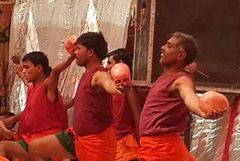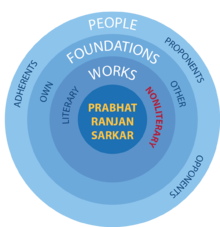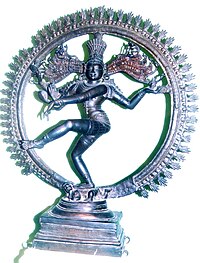Tandava: Difference between revisions
(Add) |
m (Added photo to infobox) |
||
| (15 intermediate revisions by 3 users not shown) | |||
| Line 1: | Line 1: | ||
'''''Tandava''''' is a | {{Infobox Nonliterary Works | ||
| image = [[File:AN_Tandava.jpg||240px]] | |||
| image_size = | |||
| alt = | |||
| caption = <!-- titled displayed below that image --> | |||
| abbreviation = | |||
| short_description = A vigorous dance for male spiritual aspirants that was invented by Shiva | |||
| alternative_names = Tandava dance | |||
| in_other_languages = Sanskrit/Hindi: ताण्डव<br/> Bengali: তাণ্ডব | |||
| motto = | |||
| logo = | |||
| country = | |||
| language = | |||
| website = | |||
}} | |||
'''''Táńd́ava''''' (Devanagari: ताण्डव) or '''''Tandava dance''''' (Devanagari: ताण्डव नृत्य) is a vigorous dance for male spiritual aspirants that was invented by [[Shiva]].<ref>{{cite book|title=Saḿgiita: Song, Dance and Instrumental|author=Anandamurti, Shrii Shrii|chapter=Shiva – the Embodiment of Saḿgiita}}</ref> The name of the dance is derived from the [[Samskrta]] word, ''tańd́u'', which means "jumping".<ref>{{cite book|title=Ananda Vacanamrtam Part 9|author=Anandamurti, Shrii Shrii|chapter="Wherever My Devotees Sing"}}</ref> In tandava, jumping is the main feature. Symbolically, the dance represents a fight against death and decay, the struggle of good to overcome evil.<ref>{{cite book|title=Ananda Vacanamrtam Part 5|author=Anandamurti, Shrii Shrii|chapter=[[Tandava Is a Fight|Táńd́ava Is a Fight]]}}</ref> "When Shiva Himself does this dance (''Shiva Nát́arája''), the dance becomes a metaphor in which Supreme Consciousness sends vibrations throughout the universe and causes all objects of the universe in turn to radiate vibrations."<ref>{{cite book|title=Namah Shivaya Shantaya|author=Anandamurti, Shrii Shrii|chapter=Glossary}}</ref> | |||
== Practice of tandava == | |||
[[File:Tandava.png|right|200px|Left to right, the middle row continuing indefinitely]] | |||
Tandava is practiced with the feet moving strictly in accordance with a beat. After the initial jump and before the final jump, the practitioner rapidly moves to a position in which only the balls of the feet touch the ground, and most of the dance time is spent off the ground. When practiced formally, the dancer holds a symbol of life or struggle in the right hand (for example, a dagger or a tiny drum) and a symbol of death in the left hand (for example, a skull or a snake). | |||
== Benefits of tandava == | |||
Practitioners of tandava derive various benefits. The dance enhances not just physical fitness but also manliness and courage. The dance also improves thinking and recollection.<ref>{{cite book|title=Namah Shivaya Shantaya|author=Anandamurti, Shrii Shrii|chapter=Shiva – the Focal Point of Everything (Discourse 3)}}</ref> | |||
=== Possible adverse effects === | |||
According to Anandamurti, the practice of tandava is unsuitable for females due to the strain it puts in the area of the reproductive organs. To overcome this problem for women, Anandamurti invented the ''kaośikii'' dance.<ref>{{cite book|title=Ananda Vacanamrtam Part 22|author=Anandamurti, Shrii Shrii|chapter=[[Tandava and Kaosikii|Táńd́ava and Kaośikii]]}}</ref> | |||
== Performance of tandava in Ananda Marga == | |||
All male spiritual aspirants who are physically capable of doing so are encouraged to practice tandava. On the occasions of Dharma Mahásammelana (and, also formerly, Dharma Mahácakra), the performance of tandava was made compulsory by Anandamurti. Furthermore, on those occasions a public procession with tandava dance was also compulsory.<ref>{{cite book|title=[[Ananda Marga Caryacarya Part 1]]|author=Anandamurti, Shrii Shrii|chapter=[[Dharma Mahacakra|Dharma Mahácakra]]}}</ref> | |||
== Other commentators on the subject == | |||
[[File:Shiva the Nataraja (bronze statuette).jpg|Shiva the Nataraja (bronze statuette)|right|200px|Sarkarverse Map]] | |||
According to Ananda Coomaraswamy, tandava is a pictorial allegory of what he deems to be the five principal manifestations of eternal energy:<ref>[http://www.mahashivratri.org/shiva-tandava.html Ananda Coomaraswamy, cited at www.mahashivratri.org]</ref> | |||
<blockquote> | |||
* 'Srishti' (सृष्टि) - creation, evolution | |||
* 'Sthiti' (स्थिति) - preservation, support | |||
* 'Samhara' (संहार) - destruction, evolution | |||
* 'Tirobhava' (तिरोभाव) - illusion | |||
* 'Anugraha' (अनुग्रह) - release, emancipation, grace | |||
</blockquote> | |||
== See also == | |||
* [[Lalita marmika|Lalita mármika]] | |||
* [[Kaosikii nrtya|Kaośikii nrtya]] | |||
== References == | == References == | ||
{{Portal|Shiva}} | |||
{{reflist}} | {{reflist}} | ||
[[Category:Shiva]] | |||
[[Category:Ananda Marga dances]] | |||
Latest revision as of 13:45, 6 July 2019
Táńd́ava (Devanagari: ताण्डव) or Tandava dance (Devanagari: ताण्डव नृत्य) is a vigorous dance for male spiritual aspirants that was invented by Shiva.[1] The name of the dance is derived from the Samskrta word, tańd́u, which means "jumping".[2] In tandava, jumping is the main feature. Symbolically, the dance represents a fight against death and decay, the struggle of good to overcome evil.[3] "When Shiva Himself does this dance (Shiva Nát́arája), the dance becomes a metaphor in which Supreme Consciousness sends vibrations throughout the universe and causes all objects of the universe in turn to radiate vibrations."[4]
Practice of tandava
Tandava is practiced with the feet moving strictly in accordance with a beat. After the initial jump and before the final jump, the practitioner rapidly moves to a position in which only the balls of the feet touch the ground, and most of the dance time is spent off the ground. When practiced formally, the dancer holds a symbol of life or struggle in the right hand (for example, a dagger or a tiny drum) and a symbol of death in the left hand (for example, a skull or a snake).
Benefits of tandava
Practitioners of tandava derive various benefits. The dance enhances not just physical fitness but also manliness and courage. The dance also improves thinking and recollection.[5]
Possible adverse effects
According to Anandamurti, the practice of tandava is unsuitable for females due to the strain it puts in the area of the reproductive organs. To overcome this problem for women, Anandamurti invented the kaośikii dance.[6]
Performance of tandava in Ananda Marga
All male spiritual aspirants who are physically capable of doing so are encouraged to practice tandava. On the occasions of Dharma Mahásammelana (and, also formerly, Dharma Mahácakra), the performance of tandava was made compulsory by Anandamurti. Furthermore, on those occasions a public procession with tandava dance was also compulsory.[7]
Other commentators on the subject
According to Ananda Coomaraswamy, tandava is a pictorial allegory of what he deems to be the five principal manifestations of eternal energy:[8]
- 'Srishti' (सृष्टि) - creation, evolution
- 'Sthiti' (स्थिति) - preservation, support
- 'Samhara' (संहार) - destruction, evolution
- 'Tirobhava' (तिरोभाव) - illusion
- 'Anugraha' (अनुग्रह) - release, emancipation, grace
See also
References
- ^ Anandamurti, Shrii Shrii "Shiva – the Embodiment of Saḿgiita" Saḿgiita: Song, Dance and Instrumental
- ^ Anandamurti, Shrii Shrii ""Wherever My Devotees Sing"" Ananda Vacanamrtam Part 9
- ^ Anandamurti, Shrii Shrii "Táńd́ava Is a Fight" Ananda Vacanamrtam Part 5
- ^ Anandamurti, Shrii Shrii "Glossary" Namah Shivaya Shantaya
- ^ Anandamurti, Shrii Shrii "Shiva – the Focal Point of Everything (Discourse 3)" Namah Shivaya Shantaya
- ^ Anandamurti, Shrii Shrii "Táńd́ava and Kaośikii" Ananda Vacanamrtam Part 22
- ^ Anandamurti, Shrii Shrii "Dharma Mahácakra" Ananda Marga Caryacarya Part 1
- ^ Ananda Coomaraswamy, cited at www.mahashivratri.org



